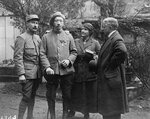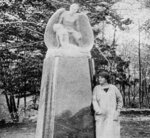





This is the second in a two-part story about Manchester's Anna Coleman Ladd, a sculptress whose impact on art and with WWI veterans was remarkable. Part I can be found here.
A FLICKERING black and white film shows a small woman in a heavy cloak walking down the street and entering her home through a side gate at 70 bis rue Notre-Dame-des-Champs.
Next, we see this same woman with her warm and lively smile touching the face of a young man smoking a cigarette. She is tending to small details about his mouth and neck. What our eyes cannot see is that much of his face is not real, but rather a carefully sculpted and painted piece of copper.
Studio for Portrait Masks
This remarkable footage captures the sculptor Anna Coleman Ladd entering her Studio for Portrait Masks. Inspired by the English artist Derwent Wood’s work in facial reconstruction, specifically sculpting prosthetic faces using tin masks, Anna established her studio in Paris to help wounded soldiers returning from the Western Front in the winter of 1918.
Having already undergone facial surgery, these men were still so horribly disfigured that France painted certain public benches blue so as to warn passersby that the man sitting on the bench would be “distressful to view.” These men were oftentimes unrecognizable even to their loved ones. They called themselves the “shattered mugs” with the motto “laugh anyhow.”
When asked of her work in Paris, Ladd explained, “They were never treated as though anything were the matter with them. We laughed with and helped them to forget. That is what they longed for and deeply appreciated.” For each mask, Ladd would take a pre-injury photo and have a silversmith create a copper prosthesis made from a mold of the man’s face. Each prosthesis was painted in natural light to exactly match the man’s skin tone. Eyes and facial hair were also created as needed.
The mask would attach to the face via glasses, if the man wore them, or with an invisible thread that went behind the ears. The mouth was always left slightly open so that the men could smoke or even, in some cases, drink tea or eat soup. Each mask took at least 20 days to complete with countless fittings, such as the one we see in the film.
Anna considered a mask successful if the man could walk down a Parisian boulevard without being noticed, but furthermore, could be with his family and know that they could once again see him, as he was before the war. A testimonial reads, “Thanks to you, the despairing rejoice, the damned return to hope, the gentle wives and mothers will again find the faces they wept for….. What Sculptor could do more? And by what precious and new words can one thank you?”
Ladd left Paris after 11 months of tireless work. Anna and Maynard had primarily financed the studio themselves and funds were lacking. By the time of her departure, Anna had completed 50 masks. Images from the studio show Anna surrounded by the men she helped, cheerfully celebrating Christmas together like a family. In December of 1918 the Ladds sailed back to Boston. Maynard returned to his medical practice and Anna to her work as a sculptor, but not as before.
The Cost of Victory
Upon her return from France, Ladd gave numerous lectures and would show slides of the soldiers and the facial prosthetics her Paris studio created. She was quoted,
“Good artists are not like you see in the movies and read about in dime novels, for those are the kind that attend social functions and champagne suppers. Quite different from the real artist who is devoted to his work, is one that will sacrifice all to obtain the highest aims. They study human faces so that they can read them and when making pieces of sculpture these readings are all brought to the surface.”
Shortly after her return, Anna began working out of a studio in Beverly Farms that she fondly called Arden. Here, her sculptural work was no longer that of playful sprites or elegant noblewomen; here, she shaped figures torn by war.
In Arden, Ladd created pieces that broke with conventional war memorials of heroic young men. The bronze “Aviator” in front of the Hamilton Community Center depicts Samuel Mandell, who left Harvard as a sophomore to enlist. He became a pilot who was killed after his plane crashed in WWI.
Ladd cast Mandell as a confident teenager with sleeves rolled up and thumb tucked into his waistband, ready to fly into enemy lands. In Beverly, Ladd carved a block of marble into a moving memorial to the local men who lost their lives in the war, entitled “The Cost of Victory”. In Ladd’s words, “And when I got back from the mud and blood around Verdun, from scenes of inconceivable heroism and horror, I dared to make War memorials with Victory as a worn and tragic figure, not a complacent woman waving a wreath.”
Indeed, in the “Cost of Victory,” Victory is carved as a mournful winged figure staring off into the distance as a naked young man dies at his feet, gazing pleadingly upward toward Victory. “When victory has been bought at such a cost of anguish, exhaustion, insomnia, ugliness, and horror, it is hardly the time for the placid waving of laurel crowns as in more sentimental days. The victors can sit back no longer: they are bound by that sacrifice of boys to live up to their ideal of a new world, to make good their hopes, to remember,” Ladd stated at the dedication of the Beverly memorial.
In Manchester, her memorial received criticism for its graphic depiction of war. Ladd was ahead of her time in design, considering it was 60 years later that another woman artist, Maya Lin, would receive criticism for the design of the Vietnam War Memorial.
As Anna continued to gain strength as an artist, she also continued to push the boundaries of women’s rights. In 1920 she was counted amongst the first women in Boston to register to vote. It was reported, “twenty women artists in the registers so far, including seventeen from Ward 8, the longtime core of the city’s art scene.” Progress, but only so much, the official at the voter registry listed her occupation as “married”.
Today
Our research on Anna led us to her grandson, a retired history professor.
Although Anna and Maynard both died before he was born, his mother, Vernon, and his aunt, Gabriella, shared many stories about their mother, Anna. During the war, Anna wrote numerous letters to her two daughters who were left with relatives in Boston when she worked in Paris. Just two works of Anna survive in the family, a bronze of Gabriella as a girl running, made just before the war years. The figure is lithe and joyous. And a marble “Slave” made post war which is more contemplative.
The Slave seems resigned to the fact that his captivity will never end. One has to wonder if the horrors of war and the maimed faces that Anna touched were somehow imparted to this beautiful piece of marble carved with the same hands. Like the faces, the marble has seen its own disfiguring over time as Anna’s Great Great Granddaughter used a bit of blue paint to add some color to the statue, without permission; Anna would be pleased that four generations later another young woman in the family is aspiring to be an artist.
Anna continued to work daily until her untimely death at age 61. One of her last pieces was a bas-relief of her husband, inscribed Maynard Ladd, Physician. Anna created hundreds of pieces in her lifetime, but only a few are on public display; many were lost.
Just months before her death, the local paper reported, “No mere seven-foot tide keeps famous Anna Coleman Ladd from her daily dip in the channel off Cabrillo Boulevard. The sculptress whose work is internationally known, goes swimming every morning, including Christmas morning. When the great swells were running and combers breaking over the seawall the other day, Mrs. Ladd went blithely in.”
We hope to continue to learn more about the life and work of Anna Coleman Ladd so that the story of her time in Manchester and Paris can be told and remembered.